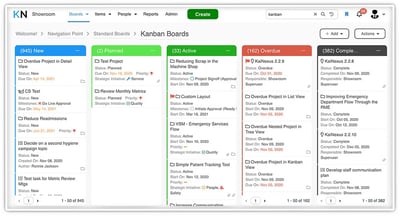 As you might expect, we write quite a bit about Lean and Six Sigma management techniques that have been modernized by moving to digital form and becoming an integrated part of a continuous improvement management platform.
As you might expect, we write quite a bit about Lean and Six Sigma management techniques that have been modernized by moving to digital form and becoming an integrated part of a continuous improvement management platform.
Huddle boards, suggestion boxes, task tracking, and improvement cycles like DMAIC and PDSA all become more effective and efficient when moved to the cloud.
When it comes to Kanban, some applications will remain in the analog world. But for the management of work-in-progress, a digital Kanban management tool can be a real game-changer.
Moving status cards off of the wall and into an improvement management platform has a number of tremendous benefits. Here are what we consider the top 10.
1. You’ll create one version of the truth and eliminate communication breakdowns
One of the things I least like to hear (or, worse yet, read in an email) is, “Did you get my email?” That is the essence of a breakdown in business communication. Maybe I did get the email and didn’t respond. Maybe I did get the email but didn’t read it. Perhaps you never really sent it. In any case, we are at square one in resolving whatever the email was about. A digital Kanban platform captures all communications about each project in one place, complete with notes and an audit log. There is one version of the truth and no need to chase down or sort through mountains of email. This makes folks more efficient and happier.
2. Meetings will become more productive
If you’ve ever been in a meeting where half of the time is spent bringing everyone up to speed and answering questions from the guy on the phone who can’t see the whiteboard, we feel your pain. That’s the beauty of digital Kanban management. Everyone has access to the status of all projects at any time so that they can be reviewed before the meeting and the time can be focused on questions, issues, and challenges. People can actively participate from anywhere, viewing the same board at the same time from wherever they are.
3. More ideas for improvement will be collected
Before a project can become a work-in-progress the idea for the improvement must be hatched and reported. Physical suggestion boxes and boards create unnecessary barriers to this sort of engagement. With a software solution, people can submit ideas whenever inspiration strikes from anywhere using their computer or mobile device. Improvement software makes it easy for people to bring up opportunities for improvement, without posing a major interruption to their workflow.
4. Improvement projects will be completed more quickly
The problem with analog Kanban signs and boards is that they are passive. Unless someone thinks to look, they might not know that a new opportunity for improvement has been submitted or that a task is due. The best online Kanban solutions offer notifications and alerts so that ideas are reviewed promptly and assignments are completed on time, moving the whole process of improvement along much faster. Nothing falls through the cracks, and leaders have a direct line of visibility into all of the improvements people are working on.
5. Leaders can assess the health of improvement culture
Even if an analog Kanban board is working well for a small team, they are not very useful for leaders who want to understand the level of engagement in improvement across the entire organization. Digital Kanban management gives leaders instant insight into what projects are underway, where a project is stalled, and where additional resources are needed - without having to travel around the company, board by board, wasting time hunting down data and answers.
6. Employee recognition becomes standard
Improvement culture thrives when people are recognized and rewarded for their efforts to enact positive change. Remembering to thank individual contributors can be a challenge for managers and leaders with a laundry list of things to do. Kanban management tools have improvement broadcasting built-in so that it becomes a routine part of project management.
7. Cross-functional collaboration is improved
The beauty of a visual, standardized Kanban system is that people from different parts of the organization can come together to solve some of the most challenging problems. People can work from different locations without losing access to the latest updates, and even diverse teams have a common language and a prescribed way to move work forward. They can search the system to see if others have solved the problems they're struggling with, loop in other teams for their expertise, and collaborate despite differences in location and schedules.
8. The organization builds a repository of knowledge
I get sad when I see a completed improvement removed from an analog Kanban board. What will become of it? Will people remember what it took to achieve that goal? Will its results be measured, and the improvement maintained for the long hall? Will another team reinvent that same wheel? Don’t let these bad things happen to your good work. A digital Kanban system means that each completed project will live on forever and be searchable by others who may find value in the lessons learned. Your organization gets smarter every time an improvement is implemented.
9. Impact reporting improves engagement from the c-suite to the front line
Leaders and employees make both financial and emotional investments in improvement work. When they see the value, they will continue to engage. If they don’t, attention will shift, and progress will stall. The best way to show everyone how this work is paying off is short and long-term impact reporting. How much money was saved, revenue earned, and goodwill produced? Analog Kanban boards can’t tell you, but the best online ones can.
It’s 2019. What a great year to adopt the perfect blend of a mid-century Japanese visual management technique and modern technical genius to power your approach to positive change.
Download this free eBook to learn how to choose an improvement platform:
How to Choose an Improvement Platform
 In this eBook, you will learn:
In this eBook, you will learn:
- Benefits of improvement software
- Does your organization need an improvement platform?
- Why not just use Excel, analog boards, or a suggestion box?
- Improvement software feature checklist
- How to evaluate vendors
- How software supports popular improvement techniques
- Implementation best practices



Add a Comment